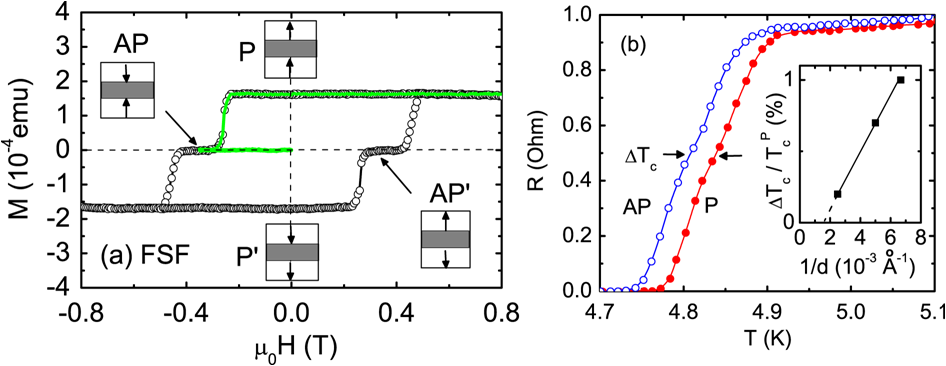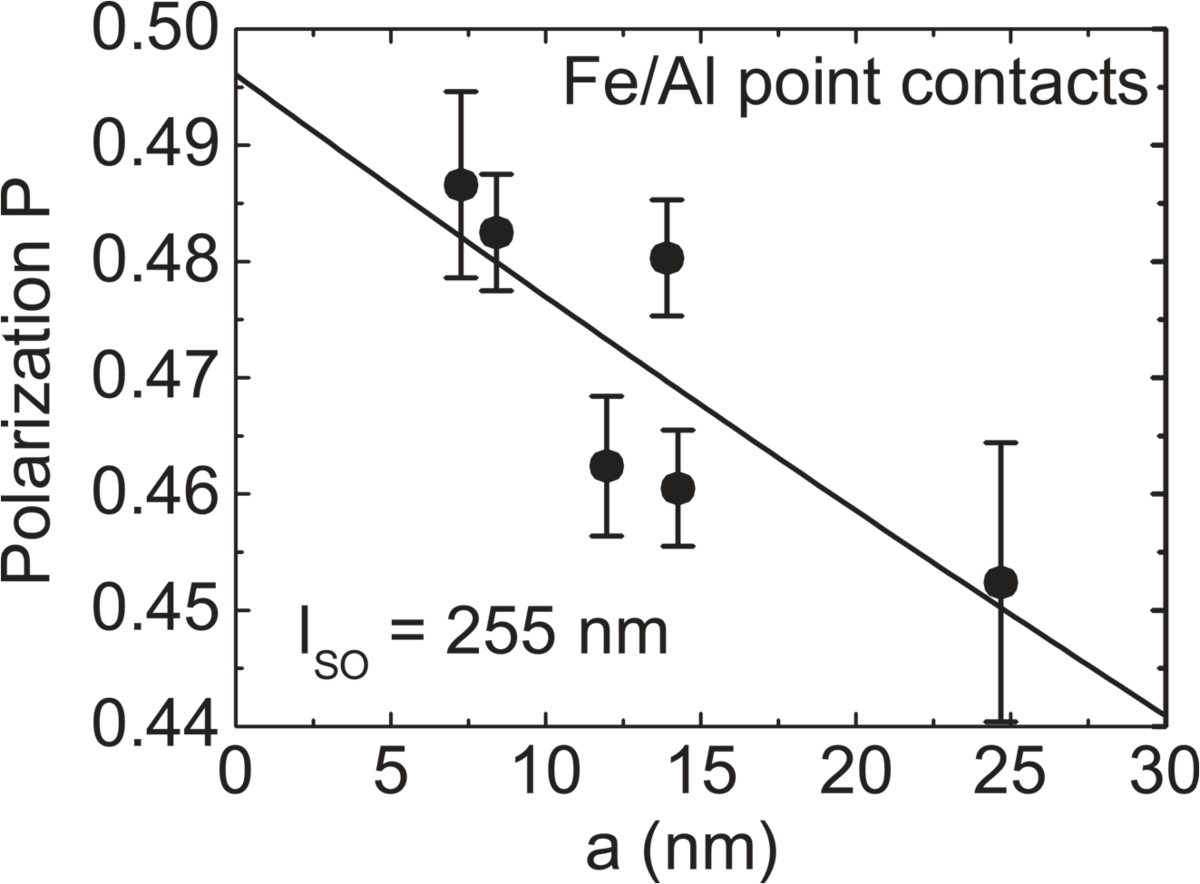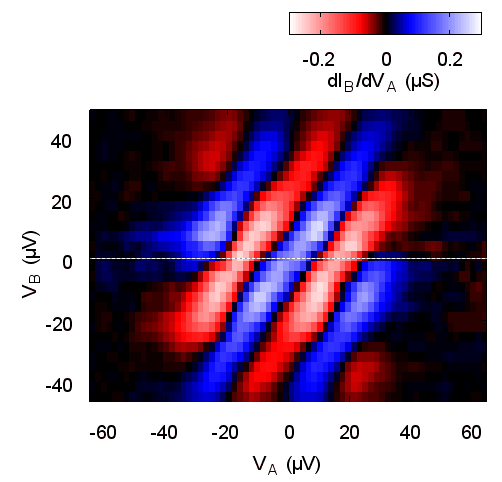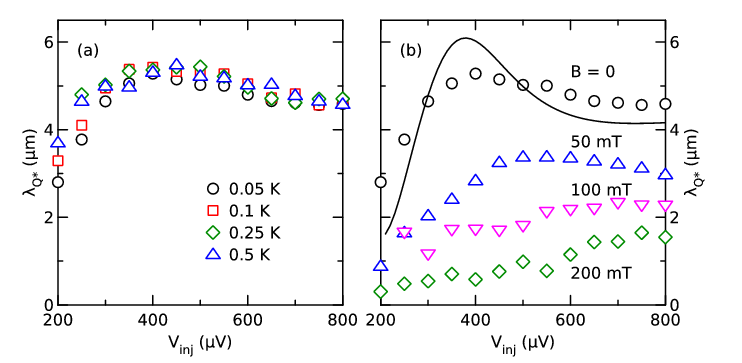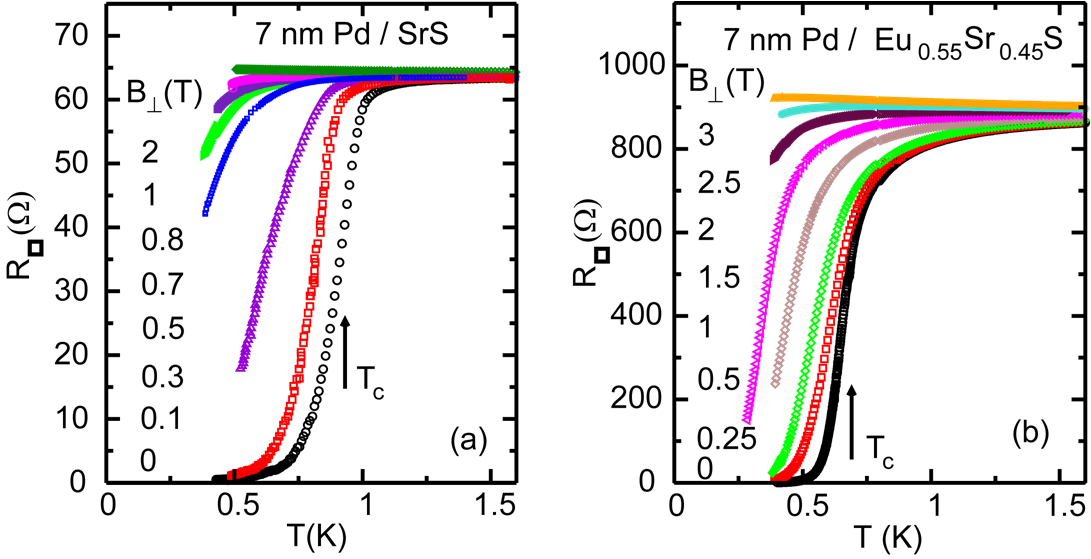Electronic Transport in Hybrid Nanostructures
In project B2.7 we investigate the electronic transport in metallic nanostructures comprised of different materials with competing electronic interactions. The focus is on superconductor/ferromagnet hybrid structures which are studied by means of electrical resistance measurements (local and nonlocal) in dependence of temperature, magnetic field, and applied voltage. These measurements allow to explore the effect of ferromagnetic order and the spin splitting of the electron conduction bands on the superconducting properties.
Superconducting Spin-Switch with Perpendicular Anisotropy
The transition temperature Tc of a superconductor sandwiched between two F layers depends on the relative magnetization orientation of the latter with respect to each other, parallel (P) or antiparallel (AP). Both positive and negative DTc = TcP - TcAP have been investigated. We have for the first time realized this superconducting spin-valve effect for sandwiches with out-of-plane magnetizations employing Co/Pt multilayers with different coercive fields for the two F layers. A low-temperature study by magnetic force microscopy on our samples [1] did not show domain walls in the MFM images acquired for the P and AP states confirming that no stray fields exist in these states (well away from the edges of the sample). The observed positive DTc is attributed to the diffusion and scattering of non-equilibrium spin-polarized charge carriers. This is corroborated by investigating F/I/S/I/F samples, where insulating (I) SiO2 films of 25 Å thickness were introduced between the F and S layers to suppress the transmission of charge carriers between the individual layers. In this case, the strong increase of TcP compared to the corresponding F/S/F sample clearly demonstrates that in this case the proximity effect is indeed suppressed. More importantly, TcP is independent of the magnetic configuration of the F layers.
Spin-Polarized Current through Superconductor/Ferromagnet Point Contacts
The spin-sensitivity of Andreev reflection through an S/F nanocontact can be employed to determine the spin polarization P of the current. We have found that P depends on the diameter of the S/F contact and approaches the bulk (equilibrium) value for small contacts [2]. We suggest that spin-orbit scattering — with a constant scattering length — is operative as the main source of the reduction of P and model the dependence P(a) by a simple exponential decay. We obtain a spin-orbit scattering length lso = 255 + 91 nm in fair agreement with the spin diffusion length lsd = 500 - 1000 nm found for Al, which may be attributed to a smaller elastic mean free path of our Al films or minor interdiffusion at the Al/Fe interface. With this interpretation, our data constitute a clear relation between the spin polarization of the Andreev current and the bulk spin polarization.
Crossed Andreev Reflection in Superconducting Hybrid Structures
Non-local transport in hybrid structures can be investigated in multiterminal devices. In particular, non-local Andreev reflection is possible if the injector (I) and detector (D) contacts are placed within the superconductive coherence length. An electron injected into the superconductor from electrode I may be reflected as a hole into a nearby electrode D, rather than into the same. This process is called crossed Andreev reflection (CAR). CAR competes with other non-local transport processes such as elastic co-tunneling (EC). We have investigated in detail the conductance due to CAR and EC, which depends on the bias applied to I and D in a complex fashion probably caused by quantum-mechanical interference [3]. Furthermore, we have measured non-local charge imbalance at ultra-low temperatures as a function of bias, contact distance, temperature, and magnetic field [4]. These results allow us to distinguish unambiguously coherent subgap transport due to CAR and EC from charge imbalance.
Superconducting State of Very Thin Pd Films Deposited on an Insulating Ferromagnet
In the course of experiments to determine the role of random magnetic fields on weak localization in Pd films we chose the dilute ferromagnet EuxSr1-xS as a substrate to provide the random fields. We surprisingly found superconductivity in very thin Pd films of 7 nm thickness [5]. We could infer from the monotonic Tc decrease with increasing Eu concentration x of the substrate attributed to pair breaking that superconductivity in Pd is of conventional s-wave character. Furthermore, the analysis of Tc(x) led to a detailed characterization of the pair-breaking mechanism.
References
|
[1]
|
A. Singh, C. Sürgers, R. Hoffmann, H. v. Löhneysen, T. V. Ashworth, N. Pilet, and H. J. Hug, Appl. Phys. Lett. 91, 152504 (2007)
|
|
[2]
|
M. Stokmaier, G. Goll, D. Weissenberger, C. Sürgers, and H. v. Löhneysen, Phys. Rev. Lett. 101, 147005 (2008)
|
|
[3]
|
J. Brauer, F. Hübler, M. Smetanin, D. Beckmann, and H. v. Löhneysen, Phys. Rev. B 81, 024515 (2010)
|
|
[4]
|
F. Hübler, J. Camirand Lemyre, D. Beckmann, and H. v. Löhneysen, Phys. Rev. B 81, 184524 (2010)
|
|
[5]
|
A. Cosceev, C. Sürgers, H.-G. Boyen, P. Schweiss, H. v. Löhneysen, Phys. Rev. B 83, 174516 (2011)
|
List of Publications 2006-2011 as PDF
Subproject Report 2006-2010 as PDF
